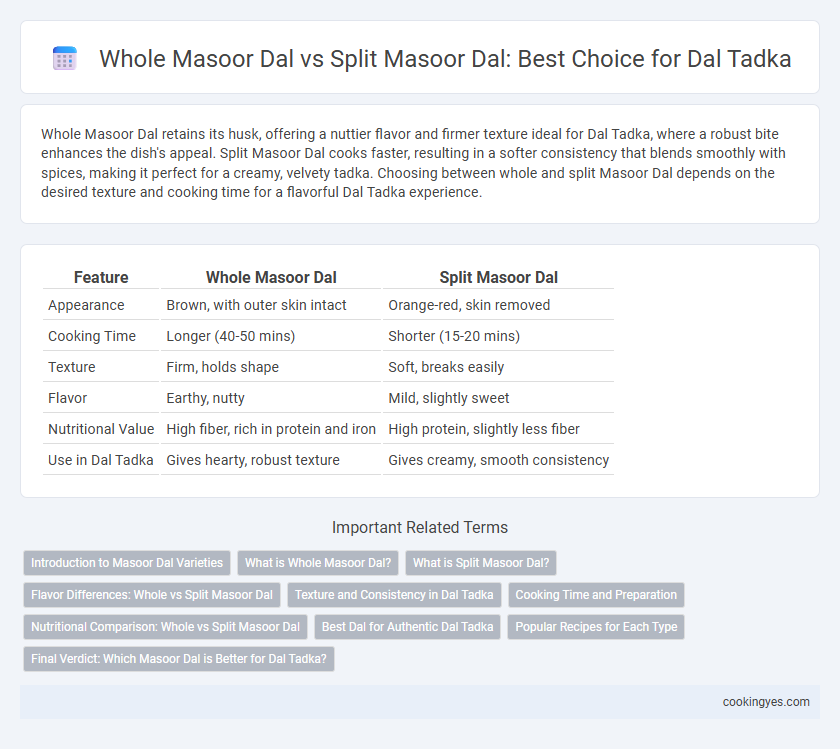Whole Masoor Dal retains its husk, offering a nuttier flavor and firmer texture ideal for Dal Tadka, where a robust bite enhances the dish's appeal. Split Masoor Dal cooks faster, resulting in a softer consistency that blends smoothly with spices, making it perfect for a creamy, velvety tadka. Choosing between whole and split Masoor Dal depends on the desired texture and cooking time for a flavorful Dal Tadka experience.
Table of Comparison
| Feature | Whole Masoor Dal | Split Masoor Dal |
|---|---|---|
| Appearance | Brown, with outer skin intact | Orange-red, skin removed |
| Cooking Time | Longer (40-50 mins) | Shorter (15-20 mins) |
| Texture | Firm, holds shape | Soft, breaks easily |
| Flavor | Earthy, nutty | Mild, slightly sweet |
| Nutritional Value | High fiber, rich in protein and iron | High protein, slightly less fiber |
| Use in Dal Tadka | Gives hearty, robust texture | Gives creamy, smooth consistency |
Introduction to Masoor Dal Varieties
Whole Masoor Dal, also known as brown or whole red lentils, retains its outer skin, providing a firmer texture and earthy flavor ideal for dal tadka preparations. Split Masoor Dal, with the outer skin removed, cooks faster and yields a softer consistency, making it perfect for creamy dals and quick meals. Both varieties are rich in protein, fiber, and essential vitamins, but their cooking times and textures influence their use in traditional Indian dishes.
What is Whole Masoor Dal?
Whole Masoor Dal is the unpolished, intact form of red lentils, retaining the bran and husk that provide higher fiber and nutrient content compared to split Masoor Dal. It takes longer to cook due to the preserved outer layer, resulting in a firmer texture ideal for recipes requiring a more substantial bite. Rich in protein, iron, and dietary fiber, Whole Masoor Dal offers enhanced health benefits and a nuttier flavor profile favored in traditional dal tadka preparations.
What is Split Masoor Dal?
Split Masoor Dal, also known as red lentils, is the husked and split version of whole masoor dal, which removes the outer skin for quicker cooking and a softer texture. This dal variety is ideal for Dal Tadka due to its faster cooking time and ability to absorb spices, resulting in a creamy, flavorful dish. Nutritionally rich in protein and iron, split masoor dal is widely preferred over whole masoor dal for its ease of digestion and smooth consistency in Indian cuisine.
Flavor Differences: Whole vs Split Masoor Dal
Whole Masoor dal retains the reddish-brown outer skin, offering a nuttier and earthier flavor with a slightly firmer texture when cooked. Split Masoor dal, with its husk removed, cooks faster and delivers a milder, creamier taste that blends smoothly in Dal Tadka. The choice between whole and split Masoor dal influences the dish's flavor depth and cooking time, with whole dal providing a more robust and textured culinary experience.
Texture and Consistency in Dal Tadka
Whole Masoor Dal retains its outer skin, resulting in a firmer texture and more defined lentil shape in Dal Tadka, enhancing bite and visual appeal. Split Masoor Dal cooks faster and yields a softer, creamier consistency that blends smoothly with tempered spices, ideal for a rich, thick gravy. Choosing between them depends on whether the desired Dal Tadka texture favors distinct lentils or a velvety, cohesive dal base.
Cooking Time and Preparation
Whole Masoor Dal requires a longer cooking time, typically around 40-50 minutes, compared to Split Masoor Dal, which cooks in about 20-25 minutes due to its smaller size and removal of the outer skin. Preparation for Whole Masoor Dal often involves soaking to reduce cooking time and ensure even texture, while Split Masoor Dal generally does not require soaking. In Dal Tadka, using Split Masoor Dal results in a softer, quicker-to-cook dish, whereas Whole Masoor Dal offers a firmer texture and more pronounced flavor, albeit with extended preparation.
Nutritional Comparison: Whole vs Split Masoor Dal
Whole Masoor Dal retains its outer husk, providing higher fiber content and a richer supply of essential nutrients like iron and B vitamins compared to Split Masoor Dal. Split Masoor Dal cooks faster and has a softer texture but contains slightly lower dietary fiber and micronutrients due to the removal of the husk. Both types offer high-quality plant-based protein, but whole masoor dal supports better digestive health and sustained energy release.
Best Dal for Authentic Dal Tadka
Whole Masoor Dal retains the outer husk, offering a nuttier flavor and firmer texture ideal for traditional Dal Tadka recipes that require slow cooking and a rustic taste. Split Masoor Dal cooks faster and produces a creamier consistency, making it convenient for quick meals but slightly less robust in flavor compared to the whole variety. For an authentic Dal Tadka experience, Whole Masoor Dal is preferred due to its superior texture and ability to absorb the tempering spices deeply, enhancing the dish's rich aroma and taste.
Popular Recipes for Each Type
Whole masoor dal retains its outer husk, offering a nuttier flavor and firmer texture, ideal for traditional dal tadka recipes that emphasize slow cooking and robust spices. Split masoor dal cooks faster, absorbing spices quickly, making it popular for quick dal tadka preparations with a creamy consistency. Recipes like Punjabi dal tadka often use whole masoor for depth, while quick South Indian dal tadka favor split masoor for convenience and smooth texture.
Final Verdict: Which Masoor Dal is Better for Dal Tadka?
Whole Masoor Dal retains more nutrients and offers a nuttier flavor, making it ideal for a textured Dal Tadka with added health benefits. Split Masoor Dal cooks faster and yields a smoother consistency, preferred for a creamy and rich Dal Tadka experience. Final verdict: choose Whole Masoor Dal for nutrition and texture, or Split Masoor Dal for ease and smoothness in Dal Tadka preparation.
Whole Masoor Dal vs Split Masoor Dal for Dal Tadka Infographic

 cookingyes.com
cookingyes.com